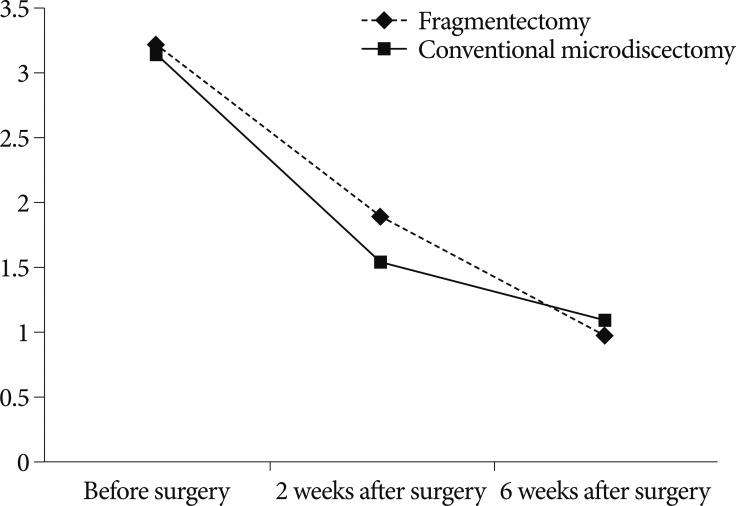J Korean Neurosurg Soc.
2012 Sep;52(3):210-214.
Fragmentectomy versus Conventional Microdiscectomy in Single-Level Lumbar Disc Herniations : Comparison of Clinical Results and Recurrence Rates
- Affiliations
-
- 1Department of Neurosurgery, Gwangju Saewoori Spine Hospital, Gwangju, Korea. yokoinim@daum.net
Abstract
OBJECTIVE
This retrospective study aimed to compare clinical outcomes in terms of pain relief and recurrence rate between fragmentectomies and conventional microdiscectomies in patients with lumbar disc herniation (LDH).
METHODS
Between January 2008 and May 2011, a total of 175 patients met the inclusion criteria of this study. The visual analogue scale (VAS) scores of back and radicular pains were recorded before surgery, 2 and 6 weeks after surgery. Recurrence was defined when a patient had the same pattern of preoperative symptoms and was confirmed with magnetic resonance imaging.
RESULTS
Seventy-four patients (42.3%) were suitable for fragmentectomy, and 101 patients underwent conventional microdiscectomy. There were no significant differences in VAS scores between the fragmentectomy and conventional microdiscectomy groups 2 and 6 weeks after surgery. During the follow-up period, 3 patients (4.05%) in the fragmentectomy group and 7 patients (6.93%) in the conventional microdiscectomy group relapsed.
CONCLUSION
If patients are selected according to well-defined criteria, fragmentectomy can be a good surgical option for LDH, in the physiological aspect of preserving healthy intervertebral disc materials.
MeSH Terms
Figure
Reference
-
1. Barth M, Diepers M, Weiss C, Thomé C. Two-year outcome after lumbar microdiscectomy versus microscopic sequestrectomy : part 2 : radiographic evaluation and correlation with clinical outcome. Spine (Phila Pa 1976). 2008; 33:273–279. PMID: 18303459.
Article2. Barth M, Weiss C, Thomé C. Two-year outcome after lumbar microdiscectomy versus microscopic sequestrectomy : part 1 : evaluation of clinical outcome. Spine (Phila Pa 1976). 2008; 33:265–272. PMID: 18303458.
Article3. Carragee EJ, Han MY, Suen PW, Kim D. Clinical outcomes after lumbar discectomy for sciatica : the effects of fragment type and anular competence. J Bone Joint Surg Am. 2003; 85:102–108. PMID: 12533579.4. Carragee EJ, Spinnickie AO, Alamin TF, Paragioudakis S. A prospective controlled study of limited versus subtotal posterior discectomy : short-term outcomes in patients with herniated lumbar intervertebral discs and large posterior anular defect. Spine (Phila Pa 1976). 2006; 31:653–657. PMID: 16540869.
Article5. Caspar W. Wullenweber R, Brock M, Hamer J, editors. A new surgical procedure for lumbar disc herniation causing less tissue damage through a microsurgical approach. Advances in Neurosurgery. 1977. Berlin: Springer-Verlag;p. 74–77.
Article6. Fakouri B, Patel V, Bayley E, Srinivas S. Lumbar microdiscectomy versus sequesterectomy/free fragmentectomy : a long-term (>2 y) retrospective study of the clinical outcome. J Spinal Disord Tech. 2011; 24:6–10. PMID: 20087226.7. Faulhauer K, Manicke C. Fragment excision versus conventional disc removal in the microsurgical treatment of herniated lumbar disc. Acta Neurochir (Wien). 1995; 133:107–111. PMID: 8748751.
Article8. Goodkin R, Laska LL. Vascular and visceral injuries associated with lumbar disc surgery : medicolegal implications. Surg Neurol. 1998; 49:358–370. discussion 370-372. PMID: 9537654.9. Kast E, Oberle J, Richter HP, Börm W. Success of simple sequestrectomy in lumbar spine surgery depends on the competence of the fibrous ring : a prospective controlled study of 168 patients. Spine (Phila Pa 1976). 2008; 33:1567–1571. PMID: 18552672.
Article10. Kim DS, Lee JK, Moon KS, Ju JK, Kim SH. Small bowel injury as a complication of lumbar microdiscectomy : case report and literature review. J Korean Neurosurg Soc. 2010; 47:224–227. PMID: 20379478.
Article11. Kjaer P, Leboeuf-Yde C, Korsholm L, Sorensen JS, Bendix T. Magnetic resonance imaging and low back pain in adults : a diagnostic imaging study of 40-year-old men and women. Spine (Phila Pa 1976). 2005; 30:1173–1180. PMID: 15897832.
Article12. Mochida J, Nishimura K, Nomura T, Toh E, Chiba M. The importance of preserving disc structure in surgical approaches to lumbar disc herniation. Spine (Phila Pa 1976). 1996; 21:1556–1563. discussion 1563-1564. PMID: 8817784.
Article13. Rogers LA. Experience with limited versus extensive disc removal in patients undergoing microsurgical operations for ruptured lumbar discs. Neurosurgery. 1988; 22:82–85. PMID: 3344091.
Article14. Striffeler H, Gröger U, Reulen HJ. "Standard" microsurgical lumbar discectomy vs. "conservative" microsurgical discectomy. A preliminary study. Acta Neurochir (Wien). 1991; 112:62–64. PMID: 1763685.
Article15. Thomé C, Barth M, Scharf J, Schmiedek P. Outcome after lumbar sequestrectomy compared with microdiscectomy : a prospective randomized study. J Neurosurg Spine. 2005; 2:271–278. PMID: 15796351.
Article16. Watters WC 3rd, McGirt MJ. An evidence-based review of the literature on the consequences of conservative versus aggressive discectomy for the treatment of primary disc herniation with radiculopathy. Spine J. 2009; 9:240–257. PMID: 18809356.
Article17. Wenger M, Mariani L, Kalbarczyk A, Gröger U. Long-term outcome of 104 patients after lumbar sequestrectomy according to Williams. Neurosurgery. 2001; 49:329–334. discussion 334-335. PMID: 11504108.
Article18. Wera GD, Dean CL, Ahn UM, Marcus RE, Cassinelli EH, Bohlman HH, et al. Reherniation and failure after lumbar discectomy : a comparison of fragment excision alone versus subtotal discectomy. J Spinal Disord Tech. 2008; 21:316–319. PMID: 18600139.
Article19. Williams RW. Microlumbar discectomy : a conservative surgical approach to the virgin herniated lumbar disc. Spine (Phila Pa 1976). 1978; 3:175–182. PMID: 663769.20. Yasargil MG. Microsurgical operation of herniated lumbar disc. Adv Neurosurg. 1977; 4:81.
Article
- Full Text Links
- Actions
-
Cited
- CITED
-
- Close
- Share
- Similar articles
-
- Comparison of the Results between Standard Discectomy and Microdiscectomy of the Herniated Lumbar Disc
- Percutaneous Endoscopic Lumbar Discectomy (PELD)
- Minimally Invasive Muscle Sparing Transmuscular Microdiscectomy : Technique and Comparison with Conventional Subperiosteal Microdiscectomy during the Early Postoperative Period
- Minimally Invasive Surgery in Lumbar Disc Herniations with MicroEndoscopic Discectomy System: Technical Note
- Paramedian Tangential Approach for the Lumbosacral Extraforaminal Disc Herniations



